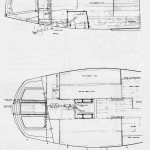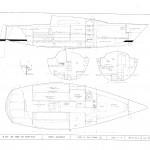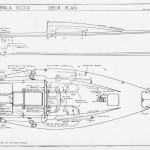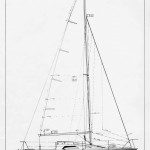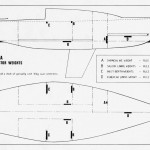- Inboard engine layout
- General Arrangement
- Impala 28 Deck Plan
- Sail Plan
- Impala 28 Corrector Weights
Object of Class Rules
This is a One-Design Class. These rules are to ensure that boats racing are as alike as possible in all respects that may affect performance in any way.
1. The administering authority for the class is the Impala 28 Class Association, which is responsible for interpreting the rules.
Protection of One-Design
1. Each yacht shall be built in accordance with these rules and with the plans as described hereunder. Alterations or additions, other than those specifically permitted by these rules, are prohibited.
2. Production moulds for the hull and deck shall be made from GRP plugs only obtainable from Hunter Boats Limited. GRP casting patterns for the keel shall only be obtainable from the master mould held by Hunter Boats Limited.
3. If it is felt that any attempt has been made to deviate from the rules or the spirit of the rules, the Class Association has the right to withdraw permission to participate in racing events until such time as it is satisfied that all such deviations are rectified.
4. Any competitor who protests a fellow competitor should adhere to the following procedure:- In the event of protest regarding a measurement which is not specifically covered by these rules, a random sample of yachts shall be measured using identical methods. The dimensions of the disputed yacht shall be equal to or between the maximum and minimum values obtained from the sample yachts. If the disputed yacht has dimensions that are outside these values the matter shall be referred to the Class Association Committee which shall give a final ruling.
5. Each yacht racing shall possess a valid class measurement certificate. This should be a requirement of any person applying for any National, International or local rating of an Impala.
6.
1. A yacht shall not qualify to take part in any race until in possession of current Association Certificate. Nor shall any results qualify retrospectively.
2. The skipper or principal helm at class regattas shall be a member of the Class Association.
7. For all Impala 28 OOD races yachts will sail with no time differences.
Hull and Deck
1. The hull and deck construction, dimensions and GRP lay-up shall be as shown in the master plan (see images at top of this page)
2. The weight of the bare assembled hull/deck unit including only the following items which shall be permanently bonded in; bow well, forecabin for/aft central support spline, hull stringers, forward w.c. compartment bulkhead, fore and aft w.c. compartment bulkhead, mast support strut, main bulkhead with chainplate backing struts, main cabin bunk sides and tops, keel bearers, aft bulkheads beneath cockpit sole, outboard motor well box, and separate mouldings for bow well lids (2), main hatch, aft locker hatches (3) shall not be less than 880 kg.
3. All items defined and described in 3.2 above shall be of dimensions as shown on the structural plans + or – 12 mm and of thickness as shown on the structural plans.
Keel
1.
1. The keel shall be of cast iron and shall be made from the official pattern.
2. A lead shoe weighing 45.45 kg cast from the official class pattern and in accordance with the One-Design plan shall be attached directly to the base of the cast iron keel defined in Rule 4.1.1.
2. The keel weight with one coat of primer shall be 851 kg + or – 14 kg.
3. The keel may be covered with paint or epoxy protective but shall not be sheathed in GRP or any other material.
4. The removal of the foundry blemishes is permitted but in no way shall the keel be ground down or built up in such a manner that departs from the standard shape as shown on the master plans.
5. The distance from the aft tip of the keel to the aft tip of the transom shall be 4,005 mm + or – 30 mm.
6. For outboard option:- Internal ballast weighing 160 kg (353.5 lb) shall be fixed in the bilge of the boat immediately aft of and adjacent to the most aft keel-bearing floor moulded into the boat as shown in the One-Design plans.
Rudder
1. The rudder shall be of wood or GRP or a combination of the two. Dimensions, sections and radii shall be in accordance with master plans.
2. Design and materials of tiller and tiller extensions are optional.
Mast
1. The mast shall be stepped on the centre line. The position of the base of the mast shall be measured from the vertical projection of the front face of the mast extrusion relative to the front edge of the horizontal surface of the mast plinth. This measurement shall be 50 mm + or – 25 mm.
2. The mast shall be of a single extrusion (minimum 90% aluminium content) with a continuous luff groove that is an integral part of the extrusion.
3. Sectional dimensions of the mast shall be 95 mm + or – 10mm athwartships and 150 mm + or – 12 mm fore and aft including the luff groove.
Sectional weight of the bare extrusion shall be no less than 3.3 kg per metre.
4. The mast may be tapered from a point 2,800 mm below the masthead up to the masthead to a minimum of 55 mm athwartships and 65 mm fore and aft.
5. Permanently bent or rotating masts are prohibited.
6. Bands of contrasting colour shall be painted on the mast, the lower band with its upper edge a minimum of 803 mm above the bottom of the mast extrusion and the upper band with its lower edge not more than 10,210 mm above the upper edge of the lower band defined above.
Mast Rigging
1. The standing rigging shall be of multistrand steel construction (except that the backstay may be made of high-tensile polymer line such as Dyneema, Spectra etc.) comprising the following items only and attached to the mast and boat only as follows:-
1. Two upper shrouds of not less than 5 mm diameter attached to or intersecting the mast at a point as shown on the spars drawing and meeting the deck at a point 833 mm + or – 15 mm from the centreline where they shall be attached to a single chain plate located on the non-sanded spot on the sidedeck as shown on the deck plan bolted to the backing strut fixed to the forward face of the main bulkhead bonded into the boat aft of the mast.
2. Two lower shrouds of not less than 5 mm diameter attached to or intersecting the mast at a point as shown on the spars drawing and attached to the same chain plate as described in 7.1.1 above, immediately inboard of the upper shrouds.
3. Both upper and lower shrouds shall be permanently fixed to the chain plate with rigging screws.
4. One permanently fixed forestay of not less than 4 mm diameter attached to or intersecting the mast at a point as shown on the spars drawing and attached to the forestay plate moulded into the stem in such a way that it intersects the deck at a point 250 mm + or – 15 mm aft of the most forward part of the deck moulding.
5. One adjustable backstay with a breaking strain of not less than 1,200 kg.
2. Two spreaders shall be permanently attached to the mast in such a way that they cannot swing. They shall be of lengths as shown on the spars drawing and attached to the mast at the position as shown on the spars drawing, shall be swept back by a minimum angle of 25 degrees and shall be fixed.
3. Three halyards (excluding main) shall be used of sufficient strength to carry sails in all conditions.
4. Tension of the rigging shall only be adjusted by means of the rigging screws on the upper and lower shrouds, the forestay adjuster and the adjustable backstay tackle. Hydraulics are prohibited.
5. A headfoil can be fitted to the forestay. If fitted it shall measure not more than 32 mm at right angles to its longitudinal axis. A furling genoa may therefore be used.
Main Boom
1. The main boom shall be of a single extrusion (minimum 90% aluminium content) with a continuous and integral mainsail foot groove.
2. Sectional dimensions of the boom shall be 62 mm to 75 mm ( + or – 5 mm ) in width, and 110 mm to 120 mm ( + or – 5 mm ) in depth including the foot groove.
3. Tapered or permanently bent booms are prohibited.
4. The sectional weight of the extrusion shall not be less than 2.0 kg per metre.
5. A band of contrasting colour shall be painted on the boom with its forward edge not more than 3,505 mm from the aft face of the mast extrusion.
Spinnaker Boom
1. No part of the spinnaker boom(s) including fittings shall be capable of extending more than 2,830 mm from the mast.
2. The point of attachment of the boom(s) to the mast shall be no more than 1,050 mm above the lower band painted on the mast.
3. The spinnaker boom(s) shall be attached to sliders running on a track attached to the front of the mast. This track shall not exceed 1,700 mm in length.
4. A jockey pole shall not be used when racing.
5. The spinnaker pole(s) shall be made of either aluminium or carbon fibre.
Sails
1. All sails shall be measured under current ISAF rules for rig measurement, unless otherwise stated. Owners’ and sailmakers’ attention is drawn to the current ISAF sail measurement rulebook as supplied by the RYA.
2. Only the following sails may be used when racing. Any sails to be used shall be carried aboard for the whole event:-
* One mainsail;
* One storm trisail;
* Up to four headsails, plus heavy weather and storm sails;
* Three spinnakers;
3. Fore and aft sails excluding heavy weather and storm sails can be made from any sailcloth that is not currently penalised under IRC. Heavy weather and storm sails shall be made from a woven fabric. Heavy weather and storm sails are as defined by OFFSHORE SPECIAL REGULATIONS Category 4 Monohulls.
* Windows not exceeding 0.30 square metres in area are permitted in any sail.
4. The mainsail shall have four batten pockets.
5. Mainsail Reefs. Boats shall conform to World Sailing Offshore Special Regulations: Category 4: Monohull regulations, except where the Offshore Special Regulations Category set out by the Organising Association for that particular race or series of races deems otherwise.
6. No part of the mainsail shall extend beyond the lower edge of the upper mast band nor beyond the inner edge of the boom band. The upper edge of the boom, projected if necessary, shall not be below the top of the lower mast band.
7. The number 2 genoa may be fitted with one reef situated as shown on the sail plan.
8. Any Spinnaker used must be symmetrical about its foot median.
9. The maximum sail dimensions (in metres) are as follows and should be measured in accordance with Rule 10.1 above.
Sail Dimensions (Metres)
Mainsail Half Width (MHW) — 2.30 metres maximum
Mainsail Three-quarter Width (MTW) — 1.34 metres maximum
Mainsail Upper (7/8) Width (MUW) — 0.77 metres maximum
Mainsail Leech — 10.90 metres maximum
Genoa Luff Perpendicular (LP) — 4.17 metres maximum
Genoa Luff Length (LL) — 9.68 metres maximum
Genoa Half Height Width (HHW) — 2.09 metres maximum
Spinnaker Area (SPA) — 39.51 square metres maximum
Where SPA is calculated as:-
SPA = ((SLU+SLE)/2)*((SF+(4*SHW))/5)*0.83
and
SLU = Spinnaker Luff
SLE = Spinnaker Leech
SF = Spinnaker Foot
SHW = Spinnaker Half Width
Interior Accommodation and Weight Correctors
1. The minimum interior structure as defined in 3.2 shall be fitted. Dimensions and thicknesses shall be as defined in 3.3. Lightening holes and cut-outs are prohibited apart from aperture(s) to allow access to the sea toilet inlet seacock, when fitted, and to the sink outlet seacock, when fitted, under the port side forepeak berth.
2. A cabin sole not less than 12 mm thick shall be fitted covering the entire main saloon floor area between the main saloon settees and from the main bulkhead to point aft of beneath the bridge deck. This sole shall be of wood or plywood.
3. Forepeak berth tops of a minimum 9 mm thickness shall be fitted as shown on the structural plans.
4. Mattresses of dunlopillow or foam construction and covered with a fabric for the full area of the main saloon and forepeak berths shall be fitted. The pilot berth mattresses shall be a minimum thickness of 50 mm. All other mattresses shall be a minimum thickness of 100 mm.
5. A 2 burner cooker shall be fitted.
1. A gas bottle of a minimum of 1.8 kg net shall be carried in a position which does not conflict with OFFSHORE SPECIAL REGULATIONS Category 4 Monohulls. Alternatively, a corrector weight of 2 kg shall be fitted in the bow well.
2. A gas shut-off valve shall be situated near all gas cookers.
6. Water tanks of a minimum 10 gallon capacity shall be carried forward of the aft keel bolt.
7.
1. A Toilet shall be fitted. This shall be a marine flushing variety or a chemical variety. Where a chemical toilet is carried, a compensatory weight of 10 kg shall be attached in a position as shown on the corrector weight plan.
2. Bulkhead toilet door must be fitted and of a solid timber construction min. 12 mm thick. It must be of a size to fully cover the bulkhead passage from the main saloon to the forecabin.
8. A battery of a minimum 60 amp/hour capacity shall be carried not more than 4.27 metres from the stem (0.50 metre aft of the main bulkhead).
9. The full galley unit structure to dimensions (+ or – 12 mm) and thickness shown on the structural plan shall be fitted on all boats.
10. Additional fittings and equipment may be installed in the accommodation or in the lockers but such items shall not include any which are specifically prohibited by these rules nor shall they be for the control of sails, spars or rigging.
11. All boats shall carry a chart table of dimensions (+ or – 12 mm) and thickness as shown on the structural plan.
12. Four compensatory weights of 10 kg each shall be carried in positions as shown on the corrector weight plan if any of the following lining details are omitted:-
* 4 mm ply panels upholstered in material and fixed to the entire underside area of the main saloon deckhead and under the side decks.
* 4 mm ply covering panels fixed to the aft face of the main bulkhead.
* Lining material glued to the hull sides and the coachroof sides of the main saloon.
13. Two corrector weights of 15 kg each shall be carried in position shown on the corrector weight plan if pilot berth structures as shown on the structural plan are not fitted in the main saloon.
14. Corrector weight of 10 kg shall be fitted in the forepeak in the position shown in the corrector weight plan if lining fabric is not glued to the hull sides and deckhead in the forepeak.
Deckgear
1. Bow and stern pulpits, and lifelines shall be fitted in accordance with OFFSHORE SPECIAL REGULATIONS Category 4 Monohulls as shown on the deckplan.
2. Six winches shall be fitted at least two of which shall be two speed. Their approximate positions shall be as shown on the deck plan.
3. Two principal genoa sheet tracks shall be fitted. These shall not exceed 1,525 mm each and shall be in positions shown on the deck plan. Two jib tracks may be fitted. The standard position of these is shown on the deck plan. Additional tracks may be fitted at the owner’s discretion.
4. The mainsheet track shall not exceed 1,530 mm and shall be shown in position as shown on deck plan.
Motor
Either
1.
1. An outboard motor shall be carried permanently mounted on the sliding pad fixed on rails in the stern motor locker. The installed motor shall weigh not less than 28 kg.
2. The outboard motor must be demonstrably capable of being lowered and propelling the yacht at any reasonable time.
3. A fuel tank shall be carried in the stern locker of a minimum capacity of two Imperial gallons.
Or
2. A Yanmar 1GM diesel may be fitted as shown in the master plan. A fuel shut-off valve must be fitted in an accessible position. A fuel tank of minimum 25 litre capacity shall be fitted in position as shown on the plan.
1. For fitted inboard diesel, flywheel to be a minimum of 196 cm aft of main bulkhead.
2. Minimum dry weight for fitted inboard 76 kg.
3. Minimum exposed shaft 620 mm.
4. A two blade folding propeller shall be fitted to the inboard diesel demonstrably capable of propelling the yacht at any time. The diameter shall be 14″ of any pitch, but with a minimum blade width of .092mm PBW.
Other Equipment
The following minimum equipment shall be carried based on ORC Category 4.
1. Yachts shall conform to ORC Category 4 safety regulations.
2. The anchor shall weigh not less than 5 kg. In addition, a minimum of 6 metres of ¼” chain and not less than 25 metres of 12 mm diameter warp shall be carried when racing.
3. At least one kettle, frying pan, saucepan, 6 sets of cutlery, 6 plates and 6 mugs shall be carried.
Flotation Rule
With the permitted and compulsory equipment on board and in the prescribed positions, freeboards shall be as follows:-
FF…… Not more than 0.945 metres.
FA…… Not more than 1.000 metres nor less than 0.900 metres.
Crew Limits
Crews shall be limited so that either:-
1. Maximum number of crew to be carried is six; or
2. The combined weight of the crew shall not exceed 500 kg.
Minimum Weight
The minimum weight of the complete boat shall be:- Outboard 2,520 kg; Inboard 2,410 kg.
For weighing, the yacht shall be fully rigged with all spars, standing rigging, halyards, vang and mainsheet and main engine installed. There shall be no sails, headsail sheets, guys, or spare running and standing rigging. All tanks empty and gas bottles removed or their weight declared and deducted. No food, cooking or catering utensils. No anchor, chain, warps, mooring lines or fenders. No clothing, bedding, or personal effects. No liferafts, dinghies, lifejackets or any other safety equipment. No tools, spare parts or other loose gear. No crew personnel.
Owners’ Responsibilities
Owners’ attention is drawn to their responsibilities with regard to these rules, and to changes to the boat since last class inspection, or IRC measurement.
THE CLASS ASSOCIATION
1. Title
The title of the Association shall be The Impala 28 Class Association.
2. Objects
The object of the Association is to promote and further develop the interests of the Impala class. In particular:
1. To maintain the one-design character of the Impala.
2. To co-ordinate and manage the affairs and rules of the class.
3. To make recommendations on the control of such matters to clubs, the RYA and other bodies.
4. To encourage and co-ordinate competition in the class.
3.
Membership
1. Full membership shall be open to any owner of an Impala. An Impala is only eligible to race under the One Design rules provided the owner, or at least one of the joint owners, is a fully paid-up member of the Association.
2. Associate membership shall be open to all individuals, clubs or organisations interested in the Impala Class.
3. Life Membership may be awarded to individuals, following a vote at an AGM, for exceptional service to the Association.
4. Every Member on joining the Association undertakes to comply with these rules.
4.
Subscriptions
1. The amount of the subscriptions shall be recommended to the AGM by the Committee.
2. Subscriptions are due on 1 January or 30 days after the date of the AGM, whichever is the later. No person shall enjoy the rights of membership of the Association until the subscription has been paid.
5.
Management
1. The Officers of the Association shall consist of the Captain, Secretary, Treasurer, Rules Secretary and Membership Secretary, with dual roles permitted but no dual-role Officer to have more than one vote.
2. The affairs of the Association shall be managed by a Committee according to the Constitution.
3. The Committee shall consist of the Officers of the Association, to number no less than three and no more than five, allowing for dual roles as specified by 5.i above.
4. The Committee may take appropriate advice from a Technical Adviser and/or Boatbuilder’s Representative.
5. The Officers shall be elected at the Association’s AGM (which may be physical or electronic), to hold office until the next AGM.
6. If a vacancy occurs on the Committee, the Committee may co-opt a Member to fill the vacancy until the next AGM.
7. All communications with Members, excepting documents requiring signature, will be paperless unless individual Members choose otherwise.
8. All Members must provide a valid email address unless opting into paper communications.
9. The Committee cannot be held responsible for any communications held to be undeliverable.
6.
General Meetings
1. The AGM of the Association will normally be held not earlier than October and not later than the following January. In any event it shall be held not later than 15 months after the date of the previous AGM.
2. The AGM may take either the form of a physical meeting or be conducted through electronic media. This format to be decided on an annual basis by the Committee.
3. At least three weeks’ notice of any General Meeting shall be given in writing (via paper or electronic media) to all Members.
4. Decisions at a General Meeting (except for amendments to the Class Constitution) shall be by a simple majority of participating Full Members. Joint owners are permitted only one vote per boat.
5. The Class Constitution may be amended by a two-thirds majority at a General Meeting.
6. The Impala OOD Class Rules may be amended by a simple majority at a General Meeting.
7.
Accounts
The Committee shall ensure that a proper record is maintained of all receipts and payments of the Association, that the Accounts are verified by an independent third party and that a proper financial statement is presented to the Members at the Annual General Meeting.
8.
Winding Up
Should the Association find itself in a position where it is no longer viable or its Objects have been overtaken by those of another organisation, the Association may be wound up by a simple majority vote of all current Full Members. In such circumstances, the assets of the Association will be ingathered and by agreement either distributed evenly amongst those Full Members remaining at the date of dissolution or donated to appropriate charitable organisations.
